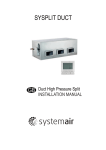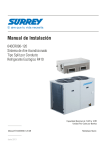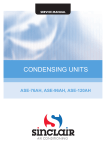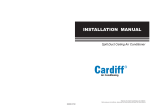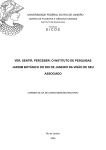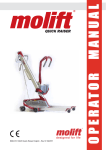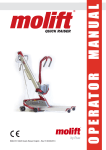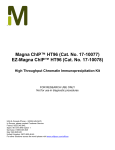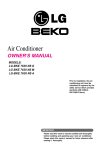Transcript
Connect to system This information may change with the update of this machine, and no further notice will be given for such change. Install the unit where it is easy to lead out the connective pipe and the drain pipe. Water connective pipe 1 Connect to water drainage pipe D isplay board subassembly 1 Connect to control signal Install the unit where no heat is emitted from a heat source directly. Protective sleeve for refrigerant inlet and outlet pipes 4 Remove controller 1 AAA battery 2 Failure to observe a warning may result in death. Failure to observe a caution may result in injury or damage to the equipment. After completing the installation, make sure that the unit operates properly during the start-up operation. Please instruct the customer on how to operate the unit and keep it maintained.Also, inform customers that they should store this installation manual along with the owner's manual for future reference. Inside a car or cabin. Place where strong electromagnetic waves exist. Ceiling Pendant bolt Over 600 mm Maintenance space The remote controller should be over 1m away from the television or sound box. Do not place the remote controller at a moist place, near the heat sources such as stove, or expose it directly in the sunlight. Ensure correct positive and negative poles when loading the batteries. Decide the correct way of conveying the equipment. Install the unit where the air inlet and air outlet are free from obstacles and strong wind. Fig.3-1 Install the unit in a dry and well ventilated place. Install the unit where the bearing surface is level and can bear weight of the unit, and is suitable for installing the unit horizontally without increasing noise or vibration. Pipe pendant embedded bolt If the a ir conditioner needs to be installed on a metal part of the building, electric insulation must be performed, and the installation must meet the relevant technical standards of electric devices. Fig.3-5 C. New concrete roughcast Set it with embedded bushes or embedded bolts. Install the unit where the operation noise and the expelling of air do not affect neighbours. drain gradient is over 1/100. 23 6 16 5 45 450 125 After the refrigerant pipe is installed completely, the indoor unit cannot be powered on before performing the airtight test and creating a vacuum. 100 Refrigerant pipe The refrigerant pipe must undergo the airtight test [with 2.94MPa (30kgf/cm2G) nitrogen]. Medium air Low air 25 Canvas adapter Canvas adapter Fig.3-2 Slide plug-in unit Blade plug-in unit Fig.3-6 Air outlet Noise suppression room Inspection orifice Air inlet Installation Manual 5~15m Use vacuum pump or refrigerant tank. Use the refrigerant in the outdoor unit to expel air(see Fig.6-8 and Fig.6-9) Start the vacuum pump to extract air. At the beginning of extracting air, slightly loosen the maintenance orifice nut of valve B, check whether any air enters it (the vacuum pump noise changes, and the multimeter indicates from negative to 0). Then tighten this maintenance orifice nut. Loosen and remove the square-head cover of valves A and B, rotate the square-head spool of valve B counterclockwise for 45 degrees and stay for about 10 seconds, and then close the spool of valve B tightly. Upon completion of vacuuming, tighten the low pressure (Lo) handle of the manifold valve completely and stop the vacuum pump. Keep extracting air for over 15 minutes. Check whether the multimeter points at -1.0X10 Pa(-76cmHg). Detect leak for all adapters at A, B, C and D. After making sure that no leak exists, open the maintenance orifice nut of valve A. After all air is expelled, tighten the maintenance orifice nut of valve A. NOTE According to the installation conditions, too large torque will damage the flaring, and too small torque will lead to looseness and leakage. Determine the tightening torque by reference to the following table. Open the spools of valves A and B completely. Tighten the square-head cover of valves A and B completely. Outdoor unit pipe pipe right Left Air side A C Manifold valve Multimeter manometer B Liquid side pipe pipe 5 4 -76cmHg pipe adapter Hi -handle Lo-handle Filler hose Fig.6-8 Filler hose The single-pass pipe is shorter than 5 m, and no additional length is required (note: The unit has been replenished before being shipped). Lo pressure valve If the single-pass pipe length is 5 m or more, the quantity of fluorine required to be replenished is 0.065X(L-5). (Unit: kg) Record the replenishment quantity of the refrigerant and keep the record properly for reference in future maintenance. Fig.6-10 Fig.7-1 NOTE Drain pipe trash gains easily at the drainage controller. Be sure to install a stopper and a structure that cleans up trash easily. Maintenance orifice Square-head spool Connective pipe port System port Pipe nut Fig.6-11 Trial draining of the drain pipe Open the side panel of the indoor unit, fill water inward, and check whether the water can be drained smoothly. Check water leak at the joint. Heat insulation of drain pipe After making sure that the water drains smoothly and no water is leaked, use adiabatic wool bushes to preserve heat of the drain pipe. Otherwise, condensate will occur. Type Mid. static pressure Power 220V-240V ~ 50Hz 220V-240V ~ 50Hz 380V~415V 3N ~ 50Hz Switch capacity of the main power suppliy/fuse(A) 20/8 Hi. static pressure 20/12 Indoor unit power cable(mm2) RVV-300/500 includes grounded wire 3×2.5 mm L N 1 2 3 Wire controller 4 A B C D E 60/40 RVV-300/500 3×2.5 mm Outdoor unit power cable(mm2) includes grounded wire YCW-450/750 5×6.0 mm connective wire of indoor outside unit RVV-300/500 4×1 mm2 Wire controls connective wire RVVP-300/300 5×0.5 mm2 Power wires Characteristics,advantages and other contents Material name Fixed-rate wire controller (option) B3 B4 Main drain pipe Air inlet wooden grille 5-cord cable RVVP-300/500 5X0.5mm2 Power supply: 220V-240V ~ 50Hz 3-cord cable 4-cord cable RVV-300/500 4X1.0mm2 1 Filter Hose(for absorbing noise) Power supply: 380V-415V 3N ~ 50Hz 5-cord cable YCW-450/750 5X 6mm 2 2 Fig.9-1 Hose(for general purpose) The power wires are as follows: (schematic diagram) 3 This wire diagram is applicable to both cooling and heating model . 6.4 Leak Detection Use soap water or a leak detector to check whether gas leakage exists at the adapters. 6.5 Heat Insulation Use heat insulation materials to wrap the part protruding outside the flared pipe joint and the refrigerant pipe of the liquid pipe and the gas pipe, and ensure that no gap exists between them. Imperfect heat insulation may lead to condensate drips. 7. INSTALL THE DRAIN PIPE Install the drain pipe of the indoor unit 8. ELECTRIC CONNECTION 1. For purpose of air inlet 2. Must adopt fire-resistant materials. (Those materials other than specified by Midea shall not be applied) 3. The heat insulation material must be glass wool. Air outlet 8 Air outlet 9 Air outlet 1. For purpose of air outlet 2. Must adopt fire-resistant materials. (Those materials other than specified by Midea shall not be applied) 3. The heat insulation material must be glass wool. Rectangular 10 Indoor unit Control wire between indoor unit and outdoor unit Electric wiring RCCB Air inlet noise pipe Indoor Unit Manual switch L N 1 2 3 Wire controller 4 A B C D E Fixed-rate wire controller (option) Indoor unit power supply Use special power supply for the air conditioner. Design power supplies specific to the indoor unit and outdoor unit. The supply voltage must comply with the nominal voltage. The external supply circuit of the air conditioner must have a ground wire, and the power supply ground wire of the indoor unit must be connected with the external ground wire firmly. 220V-240V ~ 50Hz RCCB Manual switch Outdoor unit power supply 380V~415V 3N ~ 50Hz Fig.8-1 The wiring must be performed by professional technicians according to the circuit diagram labels. Distribute the wires according to the relevant electric technical standards promulgated by the State, and set the Residual Current-operated Circuit Breaker (RCCB) properly. The drain of water is natural. In the construction, the external pipe of the outdoor unit slants downward at a gradient of 1/50~1/100. The power wire and the signal wire shall be laid out neatly and properly, without mutual interference or contacting the connection pipe or valve. The number of bends and folds of the drain pipe should not exceed 2. Try to avoid bends in order to prevent trash accumulation. In the construction, do not drop trash into the drip tray or drain pipe of the indoor unit. No power cable is attached to this equipment. The user can select the power cable by reference to the stipulated power supply specifications. No joint of wires is allowed. Upon completion of installing the drain pipe, remove the inspection panel. Put water into the drip tray to check whether the water can be drained levelly and steadily. 1. Install the fillter at the main body grille in case the storey height is low, and at the main body of the indoor unit in case the storey height is high. 2. It cleans conveniently at the time of installing/uninstalling the fillter. 3. The button structure is easy to install and uninstall. Material name Round CAUTION 11. CONSTRUCTION AND VENTILATION PIPELINE DESIGN SCHEME 4 Air outlet noise pipe 5-cord cable RVVP-300/500 5X0.5mm2 Power supply: 220V-240V ~ 50Hz 3-cord cable 2-cord cable RVV-300/500 2X1.0mm2 5 Distributor Power supply: 380V-415V 3N~ 50Hz 5-cord cable 6 YCW-450/750 5X 6mm 2 Fig.9-2 Rectangular air outlet This wire diagram is applicable to cooling only model. NOTE Pay attention to the phase sequence of the power supply. If the phase sequence is reversed, the compressor will not start. Meanwhile, the fault indicator of the outdoor electric control board will light up. For details, see Outdoor unit wring diagram on the cover plate of the electric control box . Upon completion of wire connection, double check it and then connect the power supply. 7 1. Install the unit at the air inlet so that the air flows smoothly and the noise is lower. 2. The noise value varies with the length. 3. The hose joint should be bent lest detachment of the pipe. 1. Install the unit at the air outlet so that the air flows smoothly and the noise is lower. 2. The noise value varies with the length. 3. The hose joint should be bent lest detachment of the pipe. 1. Install the unit at a diffuser so that the air flows smoothly and the noise is lower. 2. Select 1BY2 or 1BY3 according to the quantity of the diffusers. 3. The diffuser pipes should preferably have the same length after branching, and the minimum length of the ventilation pipes is 5m. 1. Fixed model that diffuses air at a 360 angle. 2. The outline size should increase when the air volume is over 350CMH. (for above 303), i.e., when about 9 diffusers are required, the outline size should increase. 3. The diffuser pipes should preferably have the same length after branching, and the minimum length of the ventilation pipes is 5m. Linear diffuser 11 Air outlet wooden grille 12 Duct wrapping tape Characteristics,advantages and other contents 1. Fixe d mode l that diffus es air at a 360 an gle . 2. The outli ne size sho uld inc rea se wh en the air volum e is over 350 CM H. (for abov e 303), i.e. , When ab out 9 diffus ers are req uir ed, the out line siz e shoul d incre ase . 3. Prop er air speed : For air spe ed of ove r 2-3.5 m/s , selec t other diffu ser s (w ith grea ter nois e). 4. Insta ll the diffus er pipe if it is nec ess ary to insta ll the mode l of ove r 3.5m/s . 5. For purp ose of cool ing -on ly mode l Warehouse Document reference room Computer room Max. actual length of pipe (L) 30m Outdoor (upper) 20m Outdoor (lower) 20m Height difference between indoor unit and outdoor unit (H) 9 Installation Manual 10 b. Leakage detection alarm device linked with the mechanical ventilation device Liquid-side connective pipe of system B Liquid-side connective pipe of system A 4.14 Completing The Connection System Name Version:MDV07I-012dW Check whether the indoor temperature conditioning is normal. Check whether the indicators illuminate normally. Check that all valves are opened before trial run. Check whether the manual operation buttons are normal. Check the electric safety before trial run. Check whether the drain function is normal. Do not perform compulsory operation in any way.(It is very dangerous if the protection device is not active) Check whether the connective copper pipes and the drain pipes generate condensate due to loose wrapping. Open the air inlet grille to check whether any penetration or leak of water occurs, especially at the drain stopper. the Check whether any vibration or abnormal sound occurs during the operation. Test whether the unit works normally in the heatig mode. Outdoor unit Check whether any vibration or abnormal sound occurs during the operation. Check whether the air, noise and condensate generated by the unit affect the neighbors. Check whether any refrigerant is leaked. Open the gas valve and the liquid valve. Connect the power supply to preheat the air 1. It is used to prevent glass wool leak and seal the gas at the time of conne cting the flanges and pipeli nes of the ventilation pipes. 2. Entwine for over 3 circles. 3. Use ventilati on pipe-spec ific tapes (instea d of ordinary adhesive tapes ). In order to ensure the installati on qualit y and durabilit y, it is necessary to use auxiliary materia ls of standard spec ificati ons provided by Midea Electr onics and the auxiliary produ cts of the specified manu factur ers. Lab Retiring room Meeting room Install the remote controller holder as required by the user. The holder must be installed in a location suitable for transmitting the signals of the remote controller to the indoor unit. Trial run Use the remote controller or wire controller (matched) to let the air conditioner run in the cooling mode. Inspect the following items against the operation manual. (If any fault occurs, remove the fault by reference to the Section headed “Faults of Air Conditioner and Causes” in the Operation Manual.) Manager office Document room After shifting the phase sequence, power on the unit until the fault indicator goes out and the compressor starts up normally. Installation Manual 11 Installation Manual 12 Installation Manual 13 Installation Manual 14 The valve of the outdoor unit should be closed completely (as in the factory status). Every time when connecting the pipe, screw off the nut at the valve, and connect the flared pipe (within 5 minutes). If the nut is put away for a long time after being screwed off the valve, dust and other foreign substance may intrude into the pipeline system and lead to fault. Before connecting the pipe, use the refrigerant (R-22) to expel air out of the pipe. After the refrigerant pipe is connected to the indoor and outdoor units, expel air as instructed in the “Expel air” section. After expelling the air, screw up the nut at the maintenance orifice. Check whether any obstacles exist at the air inlet/outlet of the indoor or outdoor unit. Kitchen Do not rest the weight of the connective pipe on the adapter of the indoor unit. Too heavy load on the adapter of the indoor unit may deform the pipe and thus affect the cooling/heating effect. In case multiple systems are set, in order to identify the connection system of the indoor unit and outdoor unit, it is necessary to give name to each system, and mark it onto the nameplate on the electric control box cover of the outdoor unit. Check whether the supply voltage is equal to the rated voltage of the air conditioner. 1. Flanges and pipelines connected to the ventilation pipes. 2. When the noise pipe is connected with the hose, the ventilation pipe tape must be applied (otherwise, with only adhesive tape, the adhesion will be weakened due to change of temperature). (Unit:mm) When connecting or disconnecting the pipeline, be sure to use two spanners concurrently. After applying the auxiliary heat insulation materials, use vinylresin tape to seal it lest water leak. Check whether the pipe length and the refrigerant amount are recorded. 1. Low noise compared with other air outlets. Applicable to tall buildings that require a long distance of air conditioning. 2. Select the ventilation pipe connection calibre according to the distance and the air speed. 3. Applicable to storey height of over 5m (for design of tall storeys such as temple, consult Midea). Drain pipe adapter Before screwing up the flared nut, apply refrigerant oil at the outer surface of the pipeline flare and the taper surface of the connection nut. Screw up the nut for 3~4 circles beforehand (see Fig.6-2). Fig.5-1 Indoor unit CAUTION Installation Manual 15 Use purchased copper pipe When the cooper pipe is purchased from the market, be sure to use the heat insulation materials of the same type (with a thickness of over 9mm). Use a thumb to bend the pipe Min. radius 100mm Fig.6-3 Fig.6-1 Indoor unit Check whether the ground cables are connected correctly. Construction and ventilation pipeline design scheme 494 5.3 Heat Insulation Of The Refrigerant Pipe 7 Check whether the functional keys of the remote controller or wire controller are normal. Use the pipe bender to make close elbow pipe. Fig.6-2 CAUTION Installation Manual Check whether the switch of the remote controller or wire controller is normal. The radio of the elbow pipe should be as large as possible to prevent flattening or crush. Apply refrigerant oil Refrigerant pipe adapter (liquid side) 327 Fig.4-12 Please conduct in accordance with “Trial Run Tenor Nameplate” on the electric control box. When bending the pipe, cut out a notch of the desired size at the bend of the adiabatic pipe, and then expose the pipe (wrap the pipe with the wrapping tape after bending it). Refrigerant pipe adapter (air side) 240 Cover heat insulation materials separately at the liquid side and the air side. Moreover, perform heat insulation thoroughly for the air-side pipes of the indoor unit, and prevent water from dripping outside the unit. 6 Bend the thin-wall connective pipe Connect the indoor unit first, and then connect the outdoor unit. The pipe bend should be handled carefully, without damaging the pipe. Please use heat-resistant materials as heat insulation materials of the air-side pipe. (e.g., EPT) a. Ventilation orifice part Gas-side connective pipe of system B Do not bend the flexible pipe for over 3 times. Measure the required length of the connective pipe, and make the connective pipes in the following procedure. If it is forecast that high humidity/temperature environment (condensate temperature is over 23℃) may exist in the ceiling, e.g., inside the ceiling with slab, ceiling which is in the same environment as the outdoor air), it is necessary to apply 10mm or thicker adiabatic wool (16~20kg/m2 ) to the refrigerant pipe and the drain pipe in addition to applying the general heat insulation materials. Enough heat insulation materials should also be applied to the refrigerant joint and the pipe joint. (The leakage detection alarm device should be installed at the place vulnerable to retention of the refrigerant) Fig.6-9 Installation Manual Fig.4-13 Indoor unit Gas-side connective pipe of system A Check whether the drain is smooth. Hall Aluminium adhesive tape 6.2 Procedure Of Connecting Pipes: CAUTION (All refrigerant is leaked) Fig.4-14 Check whether the heat insulation is perfect. 1. The fan is the adjus tab le type wh ich can ch ang e direc tion of air flow. It is use d for delux e decor atio n. 2. The outli ne size sho uld inc rea se wh en the air volum e is over 450 CM H. (3 or 4S OLT) When ab out 6 diffu ser s are requi red , the ou tlin e siz e shoul d incre ase . 3. If the pro pe r air spe ed is 2.5 5m/s an d actua l air spe ed reac hes ov er 5m /s, it is nece ssa ry to ch oos e other diff use rs (with high er nois e value s). Keep dry when installing the connective pipe. Do not let moist intrude into the pipeline system. The bend shall be preferably in the middle of the pipe length, and higher bend radiuses are preferred. Carry through heat insulation for the drain pipes thoroughly. Room in which refrigerant is leaked Installation Manual Confirm the following issues before trial operation, and box for the confirmed items. Office Install the connective pipe only after fixing the indoor and outdoor units. 5.2 Heat Insulation Of The Drain Pipe Use high-pressure nitrogen to clean the pipelines. Do not use the refrigerant of the outdoor unit for cleaning. Throttling assembly Check whether the refrigerant pipeline system is inspected for leakage. Office 5.1 Heat Insulation Of The Pipe Be sure to entwine heat insulation materials round the drain pipe which runs through the room. Fig.4-11 Check whether the piping and wiring are correct. Meeting room 5. HEAT INSULATION OF THE PIPE In the process of installing the connective pipe, do not letmmmm the air, dust or foreign substance intrude into the pipeline system. (air-side pipe) Check whether the indoor unit and the outdoor are installed properly. 1. Low noise compared with other air outlets. Applicable to tall buildings that require a long distance of air conditioning. 2. Select the ventilation pipe connection calibre according to the distance and the air speed. 3. Applicable to storey height of over 5m (for design of tall storeys such as temple, consult Midea). Outdoor unit Max. pipe length L 30m Perform trial run only after all installations are finished. Was hro om 1 The lengthwise adjustable model which diffuses air at a 360 angle. 2. With the change of the cooling/ heating air flow, the horizontal and vertical distance of the fan can be adjusted (applicable to department store and exhibition hall where the decorative effect is essential). In case frequent ventilation is impossible, please install the leakage detection alarm device linked with the mechanical ventilation device. OA Perform the trial run only after the outdoor unit has been powered on for over 12 hours. Corridor Valve body In order to prevent drain overflow, install a drainage controller at place 1 of the drain pipe. (The drainage controller is designed to smoothen the drainage when the static pressure outside the unit is high, especially at the air inlet, in addition to remove stink through the drain pipe.) Intdoor unit D Stop valve Replenishment quantity of refrigerant required for air conditioner Remove the filler hose off the maintenance orifice of valve A, and then tighten the nut. Va c u u m p u m p Fig.6-7 Loosen and remove the square-head cover of valves A and B. After opening valves A and B completely, tighten the square-head cover of valves A and B. Bush (inspection and sweep orifice) Square-head cover Loosen and remove the maintenance orifice nut of valve A, and connect the filler hose of the manifold valve to the maintenance orifice of valve A (tighten both valve A and valve B). Open the low pressure (Lo) handle of the manifold valve completely. Bush (inspection and sweep orifice) B C N Use refrigerant in the outdoor unit Screw up the pipe nuts at A, B, C and D completely. Screw up the connection pipe nut manually, and use a spanner to tighten it as shown in Fig.6-7 Left right Examples of construction and ventilation pipeline design scheme(Flowering hidden series) A Less than 5m Use a vacuum pump to expel the air (Fig.6-10 ): (For method of using the manifold valve, see the operation manual of manifold valve) If the air conditioner is relocated, be sure to use a vacuum pump or refrigerant tank to expel air. Tighten the nut Align with the connective pipe ipe Through hole (15×20 rectangular hole) Indoor Unit UCV-76/96HT In order to keep the refrigerant density below the threshold value, please install a mechanic ventilation device. (perform ventilation often) 0.065kg Allowed value Installation Manual Auxiliary materials 45+_2 Procedure of expelling air A 90+_4 Tighten the square-head cover of valves A and B. Procedure of closing the valve: Same as the procedure of opening the valve, but rotate the spanner clockwise thoroughly. BSAH-76/96HR Capacity(Btu/h) Procedure of opening the valve: Open the square-head cover, use a spanner to capture the square head and open it thoroughly. Then tighten the square-head cover. Connect the filler hose adapter to the vacuum pump. Fig.6-6 Rear p φ 9.52 Check the height difference between the indoor unit and the outdoor unit, and check the length and number of bends of the refrigerant pipeline, which must meet the following requirements: Max. height difference....20m (If the height difference is greater than 5m, it is best to put the outdoor unit above the indoor unit) Max. pipelinelength.........30m Max. number of bends....15 In order to prevent faults caused by condensate of the refrigerant pipe and drain pipe, perform condensate prevention and heat insulation properly. ≤ Density threshold: 0.3 [kg/m3 ] The bend angle shall not exceed 90°. 6.1 Preparation Before Installtion Model of indoor unit.Room name Example: The first system indoor unit (A) of the 2nd floor is recorded as: 2F 1A Measures against crossing of the refrigerant density threshold According to the diameter and length of the connective liquid-side pipe of the outdoor unit and indoor unit, calculate the refrigerant replenishment quantity. The refrigerant for replenishment is R22. Table.4-3 Quantity of refrigerant Diameter of liquid-side pipe replenished for 1 m pipe length Table.4-2 Panel for maintenance Outdoor unit B3 B4 Open the square-head spools of valves A and B completely. Upon completion of installation, open all valves before trial run. Each unit has two valves of different sizes located at the outdoor unit side. Of the two valves, one is gas valve and the other is liquid valve. The procedure of opening/closing the valve is shown in the right figure (Fig.6-11). Indoor unit B C N Loosen the valve of the refrigerant tank again, and fill the refrigerant for 6 seconds. Detect leak for all adapters at A, B, C and D. After making sure that no leak exists, screw off the filler hose. After all the filled refrigerant is expelled, screw up the maintenance orifice nut of valve A quickly. Use a spanner or a similar tool to tighten the bonnet. The bonnet tightening torque is shown in aboveTable “Tightening torque”. A 9720~11860N.cm (990~1210kgf.cm) Table.6-2 b. Pull the pipe into the rear flare of the connective nut. Bottom plane Installation Manual 10. METHODS OF CONFIGURING AND SELECTING INSTALLATION 3 B[m ] Signal wire M4 10HP Table.8-1 Outdoor unit Loosen the valve of the refrigerant tank, continue filling refrigerant for 6 seconds to expel the air, and tighten the nut of valve B quickly. From the following table, select a method of expelling air. Fig.6-5 the Connect the filler hose of the refrigerant tank with the maintenance orifice of valve A. 6.3 Expelling Air Length of connective pipe (single pass) and Power supply wire 16.0 6180~7540N.cm (630~770kgf.cm) cover 9. ELECTRIC WIRE DIAGRAM Specifications of power supply Outdoor unit 4950~6030N.cm (504~616kgf.cm) 19.0 Loosen and remove the square-head maintenance orifice nut of valves A and B. 3270~3990N.cm (333~407kgf.cm) 12.7 Open the spool until it touches the stop block. Do not attempt to open further. Drain pipe Power supply wire 1420~1720N.cm (144~176kgf.cm) Screw up the pipe nuts at A, B, C and D completely. Inspection panel Inspection panel Signal wire Torque Procedure of using stop valve A[kg] Trash and foreign matters may come into the pipe in the process of installing the refrigerant pipe. Be sure to blow them off with nitrogen before connecting the pipe to the outdoor units. 12. TRIAL RUN Use refrigerant tank to expel air (see Fig.6-8 and Fig.6-9 ) Signal wire 9.52 a. Use a pipe cutter to cut off the pipe. Burr 3 Outdoor unit 6.35 Flare Coa60/50rse If miscellaneous articles are piled around the outdoor unit, such articles must be 400mm below the top of the outdoor unit. Calculate out the refrigerant density: 4.12 Schematic Diagram Of Connection Between Indoor Unit And Outdoor Unit Indoor unit Fig.4-8 Installation Manual 2 over 100m m Pipe diameter Put on an adiabatic envelope (accessory) at connective pipe adapter of the indoor unit, and wrap it tight with the wrapping tape lest condensate and leakage. Slant In case any obstacles exist above the outdoor unit, such obstacles must be 2000mm above the outdoor unit. Table.6-1 Use a leak detector or soap water detect leak carefully to prevent leakage. 90 NOTE φ9.52 φ19.0 M6 (Unit:mm) Fig.3-12 Installation Manual over 50m m After the above steps are completed, the spool of the valve of the outdoor unit should be completely open, and the refrigerant pipeline of the indoor unit and the outdoor unit should be smooth. 1 595 Fig.4-5 Fig.3-9 Thank you very much for purchasing our air conditioner, Before using your air conditioner , please read this manual carefully and keep it for future reference. Bottom plane for piping and wiring Mid. static pressure Air filter When the pipe is led from the front, use a cover plate to seal the bottom notch in order to prevent intrusion of dust or trash. The distance of the foundation bolt is shown in Fig.4-5. Fig.4-2 Do not use oxygen, flammable gas or toxic gas in the airtight test. 4.11 Remove Trash And Moist In The Pipe Outdoor unit Top view of the outdoor unit (multiple units installed) Record the refrigerant replenishment quantity, actual length of pipe and the height difference of the indoor & outdoor units onto the operation confirmation table (on the electric control box) of the outdoor unit in advance for future reference. 0 Noise suppression room ≥1000 mm ≥1000 mm If the pipe is longer than the reference pipe, the refrigerant replenishment quantity for each outdoor unit should be calculated through the formula obtained according to the actual length of the pipe. Key points of duct connection Inspection orifice ≥200 mm Calculate out the indoor volume (B[m3]) (according to the minimum volume) Liquid side Allowed length of refrigerant pipe and height difference In case the pipe is connected from the bottom notch, install it leftward, rightward or backward after leading it out. Fig.4-4 Refrigerant replenishment 50 M12 foundation bolt Gas side 96000/76000 When the pipe is connected from the front side, the pipe can be led out through the pipe & wire panel. 4 screws for 1 unit ≥200 mm Capacity(Btu/h) The pipe can be connected from the front left lower side or the bottom notch of the outdoor unit. ≥1000 mm ≥1000 mm Table.4-1 Fig.4-7 The refrigerant pipe adapter is located inside the outdoor unit. So remove the left front board first.(four M6 screws; one M4 screw) Installation & maintenance surface Creating a vacuum Be sure to use the vacuum pump to create a vacuum of the connective pipe at both air side and liquid side concurrently. Size of outdoor unit pipes and piping methods shed at the air inlet 4.5 Refrigerant Pipe ≥200 mm Fig.4-1 The refrigerant pipe must undergo heat insulation treatment. High air 75 All pipelines must be connected closely and soundly without leak of air. The pipelines must be adiabatic and free from condensation. Note: Ensure that the minimum Install the unit where it is convenient for pipe connection and electric connection. 150 For connection of the flange plane, use non-flammable canvas adapter to prevent transmission of vibration. For its size, see the indoor unit outline diagram. Use M6X20 screws (configured on site) for connection. Snow protection The refrigerant pipes must have the specified diameter. Nitrogen of a certain pressure must be filled into the refrigerant pipe before welding. In order to suppress noise effectively, install noise suppression and sound insulation devices, especially in the noise-sensitive spaces such as meeting rooms. Embedded bolt Install the unit where no flammable gas is leaked. Try to transport this equipment with the original package. Steel bar Fig.4-10 As shown in Fig.4-4, leave an interval of 100mm between the outdoor units. ≥200 mm The gas valve and liquid valve are closed in the process of compressing the nitrogen. 4.10 Refrigerant Replenishment Quantity 4.4 Installing The Outdoor Unit Air inlet Refrigerant pipe Install a filter at an easy-to-maintain place such as intake pipe. (Otherwise, the duct will gather on the air heat exchanger and lead to fault and water leak of the air conditioner.) Inspection orifice Air outlet Compress the nitrogen at the air vent of the gas valve. Calculate the total quantity of refrigerant to be replenished (A [kg]). Total refrigerant quantity for 10HP = refrigerant replenishment quantity upon shipment (11[kg]) + additional refrigerant replenishment corresponding to the pipe length 4.9 Open All Valves Fig.4-3 Installation Check the model and name to avoid mistaken installation. Tighten the spool of the gas valve and liquid valve before compressing the nitrogen. When making the vacuum, start from the air side. 4.1 Important: Construction Checkpoints In order to prevent air flow shorting, do not keep the air inlet pipe near the air outlet pipe. 600mmX600mm Install the unit where enough space of installation and maintenance is available. 4. INSTALLATING OUTDOOR UNIT 175 B. New concrete roughcast Use embedded bolts, embedded pulling plugs, and embedded stick harness. shed at the air outlet shed at the air inlet Density threshold: Density of the Freon gas that does not harm the human body. Density threshold of R22: 0.3 [ kg/m3] Use a vacuum pump to make a vacuum. Do not use refrigerant gas to expel air. Snow protection Snow protection The airtight test is performed by using the compressed nitrogen [2.94MPa(30kg/cm2G)]. 4.8 Use A Vacuum Pump To Create A Vacuum Indoor unit The duct accessories and materials must be produced by professional manufacturers. Fig.3-4 4.6 Size Of Outdoor Unit Pipes And Piping Methods Air outlet 3.5 Fan Capacity Of Indoor Unit-Static Pressure Curve Diagram The duct design must comply with the national heating air conditioner pipeline design specifications. Fig.3-13 When welding the refrigerant pipe, in order to prevent internal oxidation of the pipe, nitrogen must be filled in. Otherwise, the oxidized chips may block refrigerating circulatory system. Fig.4-6 Snow protection facilities must be installed in the snowfall areas. (See the right figure) (in case the snow protection facilities are incomplete, faults may occur). In order to prevent influence caused by snow, set up raised pavilion, and install snow protection sheds at the air inlet and air outlet. Ensure enough space for installation and maintenance.(see Fig.4-1 and Fig.4-2) 362.5 Fig.3-11 Beam Place like kitchen where oil permeates. 250 (Unit:mm) Return air duct rivet screw hole location diagram 3.4 Design And Connection Of Duct Guard board When installing the unit, leave a space for maintenance shown in the following figure. Install the power supply at the side of the outdoor unit. For installation procedure, see the relevant installation manual. Fig.3-8 Ensure enough space required for installation and maintenance. Other special environments. Operate the remote controller within the receiving scope of the indoor unit, and direct the transmitting part of the remote controller to the receiver of the indoor unit. 362.5 Wooden span Factories where the supply voltage fluctuates seriously. Place where acid or alkali gases evaporate. Do not throw or slam the remote controller. 343 A. Wooden structure Put rectanglar sticks across the beams, and set pendant bolts. 3.1 Installation Space Hotpring area where corrosive gases exist, e.g., sulfide gas. 40 Fig.4-9 Refrigerant pipe Steel wire 4.2 Installation Space Hi. static pressure Installation of the pendant bolt in different environments. Place where flammable ga ses or materials exist. WARNING 1225 Fix the pendant bolts firmly and reliably in light of the specific situation. Seaside where the air contains much salt. CAUTION 1350 The treatment of the ceiling varies between buildings. For detailed measures, consult with the fitting-out staff. 3. INSTALLATING INDOOR UNIT The site contains mineral oils such as cutting lubricant. Pendant bolt Unit body Use Φ10 or bigger screws. The screw material is high-quality carbon steel (whose surface is zinc plated or undergoes other rustproof treatment) or stainless steel. Bottom plane NOTE Trial run Perform the trial run only after the outdoor unit has been powered on for over 12 hours. 25 WARNING Installing the equipment in any of the following places may lead to faults of the equipment (if that is inevitable, consult the supplier): Fig.3-10 (Unit:mm) Air outlet duct connection screw hole location diagram Use a hoisting device to hoist the indoor unit, align it with the installation screw, adjust the horizontality and then tighten it. Power on the indoor unit after performing the airtight test and making a vacuum. Low air NOTE The indoor unit and outdoor unit are categorized into system A and system B. When installing and connecting the indoor unit and outdoor unit, identify the label carefully, and make sure that indoor unit corresponds to the outdoor unit exactly. Otherwise, it may lead to fault of the air conditioner. 570 2 Install the unit where the supply air flow can be sent to all parts in the room. Fig.3-3 300 This air conditioner uses refrigerant R22. The R22 is safe refrigerant which is harmless and non-flammable. The room for placing the air conditioner should have a proper space. Even if refrigerant leakage occurs, the density threshold will not be crossed. Additional measures may also be taken. Precautions for the flexible part of the pipeline 31 Restriction assembly (Unit:mm) This manual 300 After the pipes between the indoor unit and the outdoor unit are connected, replenish compressed nitrogen to perform airtight test. 6. INSTALL THE CONNECTIVE PIPE NOTE 20 8 1 3.3 Suspending The Indoor Unit 1180 300 Remove the cushion for use in the transport after finishing the transport. 4.13 Refrigerant Leak Precautions 305 Purpose Installation manual Fig.3-7 In order to prevent scratch and deformity the outdoor unit, apply a guard board to the surface of contact between the steel wire and the air conditioner. Height difference between indoor unit and outdoor unit H 20m Shape 1 angle steel Air inlet side 4.7 Airtight Test Cover plate (prepared by the user) Use 4 steel ropes of a f6mm or bigger size to hoist the outdoor unit and convey it into the room. In order to prevent misoperation of the air conditioner, do not interleave or entwine the power cable (380V-415V 3N~ 50Hz) with the connection wires (low-voltage wires) of the indoor/outdoor unit. Medium air In case the refrigerant pipe is led out of the bottom, as a foundation of the beam, take it at over 500mm. Max. height difference Qty. Inspect and make sure the piping and cabling are correct before powering on the air conditioner. The safty precautions listed here are divided into two categories. In either case, important safty information is listed which must be read carefully. Split Duct Air Conditioner Accessory name Owner’s manual 450 Install the unit where the air inlet and outlet are not baffled and are the least affected by external air. Supportive Pendant bolt 25 When installing the indoor unit and its accessory pipes, adhere to this user’s manual as far as possible. Table.2-1 Over 500 mm INSTALLATION MANUAL The air conditioner must be installed by professional technicians. Install the unit where the ceiling is horizontal and enough for bearing the weight of the indoor unit. High air Not less than 30 Read this user manual carefully before installing the equipment. 4-12×72 840 800 Precautions before reading the installation manual. Select the power supply capacity and wire size according to the design manual. The power wire size of the air conditioner should be greater than that of ordinary motors. 390 If in the wire control mode, the accessories do not include display panel assembly remote controller or mounting bracket. Install the unit where enough space of installation and maintenance is available. 4.3 Convey Outdoor Unit Electric wiring 390 Suspended bolt Pendant bolt hole NOTE 1350 Over than 500 mm CAUTION D. Steel beam and girder structure Set and use supportive angle steel. 760 1. PRECAUTIONS 3.2 Install Φ10 Pendant Bolts Or Ground Bolts 735 2. ACCESSORIES (INDOOR UNIT) 202000170330 Installation Manual 8 Method of unleashing the spooled pipe. Straighten the pipe end Fig.6-4 Deploy the pipelines Drill a porthole on the wall, and put the hole sheath and hole cover through the wall. Place the connective pipe together with the indoor & outdoor connection wires. Use wrapping tape to tie them tight. Do not let air penetrate into it lest condensation and drips of moist. Pull the connective wrapped connective pipe from outdoor through the sheath which gets through the wall, and lead it into the room.Lay out the pipelines carefully lest damage to the pipes. Make a vacuum of connective pipeline.
